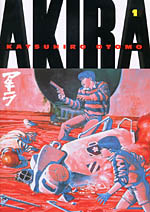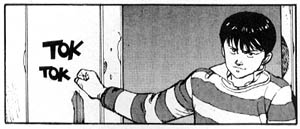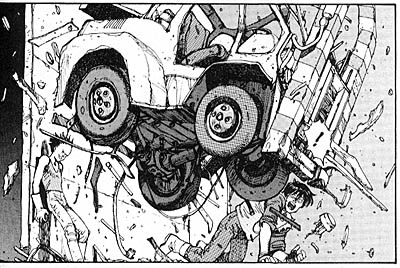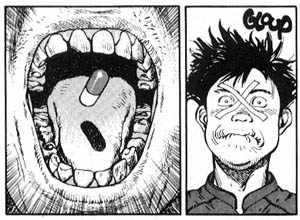 By Katsuhiro Otomo
By Katsuhiro Otomo
368 pages, black and white
Published by Kodansha Comics
Reading Akira makes me feel a little old. It probably has to do with first encountering Akira 20 years ago, early on in Marvel’s colored reprints of Katsuhiro Otomo’s epic. From there, Dark Horse eventually reprinted the series as six "phone book" sized paperbacks around the turn of the century. Now, Japanese mega-publisher Kodansha is kicking off its own official North American publishing imprint, Kodansha Comics, and they’re using Akira as one of their first two books. While the content is still sound, in terms of actual production it’s a little surprising in places.
 Akira opens as the world is still reeling from 1992’s World War III; while it may be 2030, the globe is clearly trying to finish rebuilding. Otomo starts Akira small, focusing on a group of high school students who are more interested in popping pills and riding motorcycles than going to school or anything else in life. Kaneda, their leader, is the kind of protagonist who is charismatic despite is shallow, slightly-callous personality. When the school nurse tells him that she’s pregnant—with the clear insinuation being that he’s the father—his response is a flippant, "Hey great! Can I watch you have it?" Later on when she’s clearly had enough of his devil-may-care, take-no-responsibility outlook on life, she slams the door in his face, and he has no idea what’s bothering her so much. He’s crass and prone to bad decisions, but at the same time his cocky attitude and great self-confidence makes him the sort of character that you almost can’t help liking.
Akira opens as the world is still reeling from 1992’s World War III; while it may be 2030, the globe is clearly trying to finish rebuilding. Otomo starts Akira small, focusing on a group of high school students who are more interested in popping pills and riding motorcycles than going to school or anything else in life. Kaneda, their leader, is the kind of protagonist who is charismatic despite is shallow, slightly-callous personality. When the school nurse tells him that she’s pregnant—with the clear insinuation being that he’s the father—his response is a flippant, "Hey great! Can I watch you have it?" Later on when she’s clearly had enough of his devil-may-care, take-no-responsibility outlook on life, she slams the door in his face, and he has no idea what’s bothering her so much. He’s crass and prone to bad decisions, but at the same time his cocky attitude and great self-confidence makes him the sort of character that you almost can’t help liking.
 As Akira progresses, though, Kaneda’s world slowly begins to expand. Instead of his biggest worry being the rival Clown gang, he starts learning about both a top-secret military project that is somehow connected to the explosion in Tokyo that kicked off World War III, as well as an underground resistance trying to learn the military’s secrets and topple them. Otomo makes Kaneda and fellow student Tetsuo wild cards in the mix, both of them creating waves of chaos that ripple outward with every new move they make. By the end of the first volume, things have changed in a big way; an underling is gaining great power, while a leader is turning into a small fish in a huge ocean. Having read all of Akira also enables one to look back at this first volume and see hints and portents about what’s still to come in the remaining five volumes. Before sitting down with this latest edition of Akira I’d unfairly characterized some big plot decisions that come later as Otomo making things up on the fly, but the largest surprises of all are clearly mapped out right from the start.
As Akira progresses, though, Kaneda’s world slowly begins to expand. Instead of his biggest worry being the rival Clown gang, he starts learning about both a top-secret military project that is somehow connected to the explosion in Tokyo that kicked off World War III, as well as an underground resistance trying to learn the military’s secrets and topple them. Otomo makes Kaneda and fellow student Tetsuo wild cards in the mix, both of them creating waves of chaos that ripple outward with every new move they make. By the end of the first volume, things have changed in a big way; an underling is gaining great power, while a leader is turning into a small fish in a huge ocean. Having read all of Akira also enables one to look back at this first volume and see hints and portents about what’s still to come in the remaining five volumes. Before sitting down with this latest edition of Akira I’d unfairly characterized some big plot decisions that come later as Otomo making things up on the fly, but the largest surprises of all are clearly mapped out right from the start.
 Any artist whose career began the past 20 years that uses speed lines a great deal can probably trace that piece of their style backwards to Otomo. He really knows how to use them, though, in a way that few artists have mastered. They do more than just indicate motion; they’re a carefully patterned background that radiate outwards, forming a beautiful geometric pattern that ends up being a piece of art in their own right. Of course, there’s a lot more to Otomo’s art than just speed lines. I love the way he draws his characters, from Kaneda’s puckish face to Kei and Ryu’s determination (and occasional exasperation). There are scenes that, twenty years later, still remain visually fresh in my mind as when I first saw them. Such simple moments as Masaru trying to throw Takashi his medicine, or members of Kaneda’s gang popping hallucinogens before going out for a spin, are drawn with such care and expression. Even the backgrounds of Neo-Tokyo under Otomo’s pen are amazing, with new growth coming up amidst ruined buildings, and the dank underground passages that the resistance and military both use for their covert operations.
Any artist whose career began the past 20 years that uses speed lines a great deal can probably trace that piece of their style backwards to Otomo. He really knows how to use them, though, in a way that few artists have mastered. They do more than just indicate motion; they’re a carefully patterned background that radiate outwards, forming a beautiful geometric pattern that ends up being a piece of art in their own right. Of course, there’s a lot more to Otomo’s art than just speed lines. I love the way he draws his characters, from Kaneda’s puckish face to Kei and Ryu’s determination (and occasional exasperation). There are scenes that, twenty years later, still remain visually fresh in my mind as when I first saw them. Such simple moments as Masaru trying to throw Takashi his medicine, or members of Kaneda’s gang popping hallucinogens before going out for a spin, are drawn with such care and expression. Even the backgrounds of Neo-Tokyo under Otomo’s pen are amazing, with new growth coming up amidst ruined buildings, and the dank underground passages that the resistance and military both use for their covert operations.
Akira Vol. 1 is a handsome book, there’s no question about that. What’s curious about this edition, though, is that we’ve already seen it before. Kodansha Comics clearly bought (or at least licensed) the previous translation, art touch-ups, and formatting of the Dark Horse Comics edition of Akira. While some elements were almost certain to carry over—the Dark Horse edition used the same cover design as the Japanese, for example—I was surprised to find everything identical. The changes in the art to change sound-effects from Japanese to English, the translation by Yoko Umezawa, Linda M. York, and Jo Duffy, even the flipping/mirroring of the pages so that the book reads left-to-right (since unflipped books weren’t accepted by the reading public at the time of Dark Horse’s edition). Aside from swapping out the Dark Horse logo, a new (brief) introduction text piece by Otomo, and an after word by Dark Horse publisher Mike Richardson, it’s the same book. While I’ve always felt that the translation of Akira flowed smoothly and "sounded" good (and which goes back all the way to the Marvel days), I was surprised to see that what we’ve come to expect now from manga being brought into English—unflipped pages, unaltered art—was clearly not a priority. It’s a strange decision to make, one that makes me feel like this new version of Akira is being done on the cheap, or at least the road of least effort. (On the bright side, people who have incomplete collections of the Dark Horse edition can fill in the gaps with these new editions and not have to worry about different shaped or sized books.)
Still, there’s no doubt in my mind that Akira is a seminal work of comics that just about everyone interested in the medium should read. It blazed paths forward that people are still following decades later, and it’s a thoroughly engaging work to boot. I’m slightly envious of people who are just now discovering Akira, because they have an amazing experience ahead of them. One of the masterpieces of the 20th century, Akira is the kind of comic that most creators wish they could create. If you’ve never read Akira before, you’re getting a third chance. Don’t pass this by again.
Purchase Links: Amazon.com | Powell’s Books
